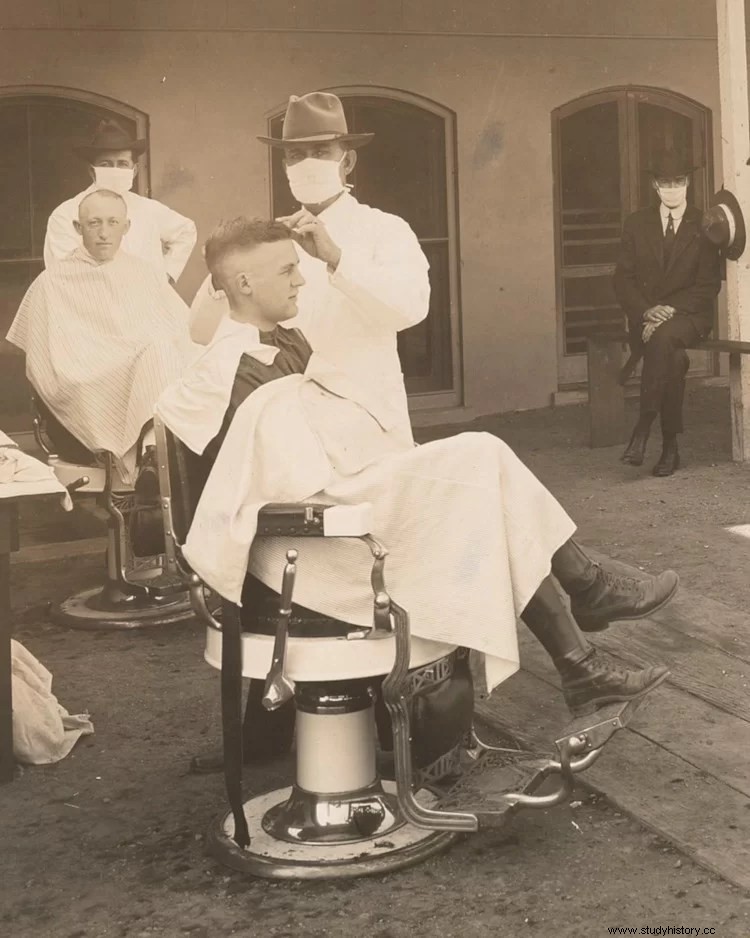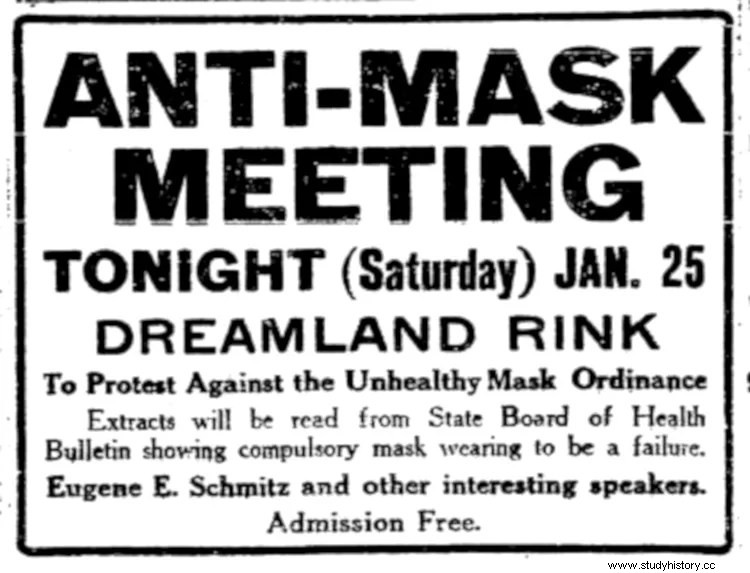A few days ago we saw how a handful of armed people broke into the Capitol of Michigan (USA), during the debate that politicians were holding to determine whether to extend the state of emergency due to Covid-19. The truth is that this type of raucous reaction is typical of certain sectors of the North American country and, in fact, it is not the first time that it has occurred in the context of a pandemic:the Spanish flu outbreak of 1918 also led to the organization of something as outlandish as the Anti-Mask League of San Francisco , a group of citizens who were radically opposed to wearing masks in the face of government demand.
The Spanish flu was a disease caused by the human A H1N1 , an Alphainfluenzavirus of the family Orthomyxoviridae that had the characteristic of being able to seriously affect not only children and the elderly but also young people and healthy adults (and domestic animals).
Something that was aggravated by the situation that the world was experiencing at that time:the First World War, which, like any war, increased the effects of the pandemic by weakening organisms (malnutrition, lack of hygiene, diseases) and facilitating contagion (health conditions). life among the soldiers, the return home, etc).

Although in the autumn of 1917 there seems to have been a first wave in several military camps, at that time it was not yet so lethal and it was not officially documented until March 4, 1918 at Fort Ridley (Kansas, USA). However, that summer the virus underwent a fateful mutation that gave it its deadliest form, manifesting itself in Brest, France, the main port of landing for US troops sent to Europe. From there it would spread through France and then spread to the United Kingdom, Italy, Germany and other countries on the continent.
Among them was Spain, where he arrived despite not participating in the war. Paradoxically, this neutrality meant that there was freedom of the press on the subject, in the face of censorship by the belligerents, and the news published in this regard led to the impression that it was the only country affected, the origin of the contagion to the others. Consequently, following a headline in The Times the erroneous name of Spanish flu was generalized , with which he has gone down in history. Even so, it had 200,000 deaths and followed the same periodization as the others, with three waves, two in 1918 -the most serious- and another in 1919, plus a small rebound in 1920, the latter with a less significant incidence due to the development of immunity group.

Although not often taken into account, the pandemic affected the conduct of the war because Germany had to admit up to a million soldiers to hospitals, something that inevitably affected its operational capacity. In fact, 40 to 50 million deaths were recorded, with a mortality rate calculated -according to sources- between 10% and 20% of the infected population, with the contagion rate close to 50% of the world population.
High fever, vomiting, diarrhea, shortness of breath, exhaustion, and a grayish skin tone were some of the symptoms, which tended to worsen and could end up causing death within a maximum period of five days.
The country with the highest mortality is supposed - about 30 million, although there are no reliable data - was China, which some researchers place as a possible source of contagion. Despite the lack of conclusive evidence in this regard, it is the United States where the main focus is today and where there were the most deaths in the Western world, between half a million and 675,000 people, with 28% of the infected population. These high statistics were due to overcrowding in hospitals, lack of ventilation and the accumulation of corpses in morgues and cemeteries.

In addition, the rapid increase in infections caused a shortage of antibiotics, which resulted in death from secondary bacterial pneumonia, added to that of massive acute pulmonary hemorrhage and pulmonary edema. At first, the US government considered interrupting the sending of troops to Europe, but in the end the military criterion was imposed and nothing was changed, so that a total of one and a half million troops made the Atlantic crossing, many of them sick and , often dying during the journey.
Now, what interests us here is the case of San Francisco. The epidemic was detected in the Californian city at the beginning of the autumn of 1918, the first case being documented in the last days of September. Two weeks later the sick already numbered two thousand, which led the Health Board to take action on the matter by adopting the first preventive measures:closure of public places (schools, theaters...), prohibition of gatherings and a call to the population to try to keep their distance, away from the crowds.

Given the seriousness of the news that came from other places, it was decided to expand security by decreeing the obligation to wear a mask for all risk professions, such as hairdressers, cashiers, shop assistants, pharmacists and, in general, anyone who works face-to-face. to the public. On the 25th of that same month, that order was extended to all citizens who left their homes or gathered in groups of two or more individuals; it was only allowed to remove them at meals.
Although there were some complaints, the vast majority of people accepted the rule without much problem and, thus, 80% wore a mask, either out of awareness (those who did not comply were disqualified as lazy), or because of the cunning promotion that was made (they presented it as a fashion), and because of the fines and even imprisonment for those who disobeyed, under the accusation of disturbing the peace. And the example spread when the health delegate, two judges and an admiral paid a penalty for being caught without a mask; even the mayor, James Rooth, was caught going to a boxing match without her and had to pay. Of course, there was also some official who tried to make disobedient people see reason… with shots!

Meanwhile, the Red Cross, to which the amounts of the aforementioned fines (between 5 and 10 dollars) were donated, was in charge of selling masks at low prices at strategic points such as railway stations, trams or the ferry terminal. In the second half of November, the number of infections subsided and the war ended, so, to the general rejoicing, the obligation to cover the respiratory tract was withdrawn. However, during the following two months the number of people affected soared again and at the beginning of the new year it was necessary to go back, establishing its use again on January 17, 1919.
Too much for the reticent, who considered “burdensome” having to go masked and this time they organized themselves to carry out a more serious and coordinated protest. It was then that the Anti-Mask League of San Francisco was founded. , which under the chairmanship of Mrs. E. C. Harrington held its seminal meeting only a week later, on the 25th, at the former Dreamland skating rink. Despite representing 1% of the inhabitants, it was not a minority group of eccentrics; The event was attended by no less than 5,000 people, including not only the typical staunch defenders of civil rights that are usually found in the US, but also several doctors and even directors of the public health system.

The debates revolved around various topics, from the violation of the individual freedom of the citizen, to the doubts about the degree of veracity of the scientific reports, passing through the possibility of presenting dismissal petitions against the politicians in charge of municipal health.
But its commissioner, Dr. William C Hassler -to whom someone sent a bomb that, luckily, produced no casualties-, stood firm, not only having the support of the mayor -whose wife was ill- but also with that of businessmen and unions.
The curious thing is that senior health executives from other cities and the state joined the protest movement arguing that the masks were not necessary or useful, which led to discussions with their counterparts who did defend them. Meanwhile, the controversy continued and while some members of the league were preparing to collect signatures against the masks, others presented an official request for the measure to be revoked. The national and international press echoed the controversy, although it was to be something ephemeral.

And it is that nature itself was responsible for putting an end to the matter. As we said before, that third wave of 1919 was less virulent than the two predecessors, having generated defenses in organisms -perhaps also by mutating the virus to a lighter form-, so, whether due to the remission of the disease or the pressure from the League, the fact is that in February the requirement to wear a mask was lifted. Ironically, the league was right:at that time all masks were made of gauze instead of cotton, and they did not work to prevent contagion.
